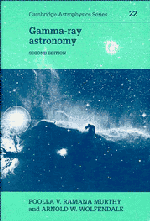4 - Medium energy gamma-rays
Published online by Cambridge University Press: 06 July 2010
Summary
Introduction
For reasons concerned with the availability of contemporary γ-ray data, the lower limit for ‘medium energy’ quanta can be taken as 35 MeV (this is the lower limit for the important SAS II satellite experiment). The upper limit again comes from satellite data availability and is rather arbitrarily taken as 5000 MeV, the upper limit of the highest COS B satellite energy band; in fact, the photon flux falls off with energy so rapidly that our knowledge about γ-rays above 1000 MeV from satellite experiments is virtually nil. As will be discussed in Chapter 5, however, knowledge blooms again above 1011 eV, where Cerenkov radiation produced by γ-ray-induced electrons in the atmosphere allows detections to be made.
Although there are some who still believe that unresolved discrete sources contribute considerably to the diffuse γ-ray flux, the majority view is that the sources are responsible for only 10−20% of the γ-ray flux and that the predominant fraction arises from cosmic ray (CR) interactions with gas and radiation in the interstellar medium (ISM). In fact, some 30 years ago, both Hayakawa (1952) and Hutchinson (1952) had made estimates of the CR–ISM-induced γ-ray flux and had shown it to be within the scope of experimental measurement.
The foregoing is not to say that the discrete sources are unimportant, indeed the reverse is true, and there is considerable interest in ways of explaining the observed γ-ray flux from identified sources (the Crab and Vela pulsars) and the unidentified but definite sources such as Geminga (2CG 195 + 04 in the COS B source catalogue of Hermsen 1980, 1981).
- Type
- Chapter
- Information
- Gamma-ray Astronomy , pp. 111 - 172Publisher: Cambridge University PressPrint publication year: 1993



